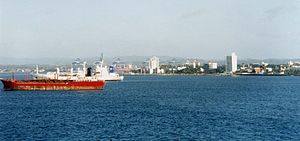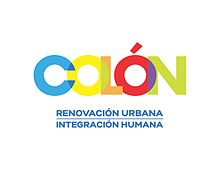Colón, Panama
Colón | |
|---|---|
City | |
| Ciudad de Colón | |
 | |
| Coordinates: 9°21′26″N 79°53′55″W / 9.35722°N 79.89861°W | |
| Country | |
| Province | Colón Province |
| Government | |
| • President | Juan Carlos Varela |
| • Mayor | Federico Policani |
| Elevation | 9 m (30 ft) |
| Population (2010) | |
| • City | 78,000 |
| • Metro | 220,000 |
| Area code | +507 |
| Website | |
Colón (Spanish pronunciation: [koˈlon]) is a Panamanian city and sea port beside the Caribbean Sea, lying near the Atlantic entrance to the Panama Canal. It is the capital of Panama's Colón Province and has traditionally been known as Panama's second city. Originally, it was located entirely on Manzanillo Island, surrounded by Limon Bay, Manzanillo Bay and the Folks River, but, since the disestablishment of the Panama Canal Zone, the city's limits have been redefined to include Fort Gulick, a former U.S. Army base, as well the former Canal Zone towns of Cristobal, Margarita and Coco Solo.
History
The city was founded by Americans in 1850 as the Atlantic terminal of the Panama Railroad, then under construction to meet the gold rush demand for a fast route to California. For a number of years early in its history, the sizable United States émigré community called the town Aspinwall after Panama Railroad promoter William Henry Aspinwall, while the city's Hispanic community called it Colón in honor of Christopher Columbus. The city was founded on the western end of a treacherously marshy islet known as Manzanillo Island. As part of the construction of the Panama Railroad, the island was connected to the Panamanian mainland by a causeway and part of the island was drained to allow the erection of permanent buildings.
Much of the city was burned during the Colombian Civil War of 1885 and again during a massive fire in 1915. The Great Colon Fire of April 13–14, 1940 destroyed one third of the city.[1]
Fort De Lesseps
Fort De Lesseps was a small U.S. Army Coast Artillery Corps fort located at the northern tip of the city. It was named after the canal developer Ferdinand de Lesseps.
From 1948 to 1989
In 1948, the southeastern corner of Manzanillo Island was designated as the Colón Free Trade Zone. The Free Trade Zone has since been expanded through land reclamation on the Folks River and annexation of parts of France Field (now Enrique Adolfo Jiménez Airport) and Coco Solo.
During its heyday, Colón was home to dozens of nightclubs, cabarets, and movie theaters. It was known for its citizens' civic pride, orderly appearance, and outstanding native sons and daughters. Politically instigated riots in the 1960s destroyed the city's beautiful municipal palace and signaled the start of the city's decline, which was further accelerated by the military dictatorships of Omar Torrijos and Manuel Noriega from 1968 to 1987.

Since late 2014

A massive restoration and reconstruction project, involving parks, avenues and historic buildings and monuments, began in late 2014[2] and uses the hashtags #RenovaciónColón, #CiudadDeColón, #RenovationColon (Renovation of Colón) and #CityOfColon. The First Baptist Church of Colón, Panama, is one of the buildings whose renovation has been completed.
Climate
Colón has a tropical monsoon climate with heavy rainfall from May to December.
| Climate data for Colón | |||||||||||||
|---|---|---|---|---|---|---|---|---|---|---|---|---|---|
| Month | Jan | Feb | Mar | Apr | May | Jun | Jul | Aug | Sep | Oct | Nov | Dec | Year |
| Mean daily maximum °C (°F) | 29 (84) |
29 (84) |
29 (85) |
30 (86) |
31 (87) |
30 (86) |
29 (85) |
29 (85) |
31 (87) |
30 (86) |
29 (84) |
29 (84) |
29 (85) |
| Mean daily minimum °C (°F) | 24 (76) |
24 (76) |
24 (76) |
25 (77) |
24 (76) |
24 (75) |
24 (75) |
24 (75) |
24 (75) |
23 (74) |
23 (74) |
24 (75) |
24 (75) |
| Average precipitation mm (inches) | 110 (4.3) |
51 (2) |
36 (1.4) |
94 (3.7) |
270 (10.8) |
370 (14.5) |
420 (16.5) |
420 (16.4) |
290 (11.5) |
470 (18.4) |
620 (24.4) |
320 (12.6) |
3,470 (136.5) |
| Source: Weatherbase[3] | |||||||||||||
Population
Colón's population in 1900 was 3,001. It grew significantly with the building of the Panama Canal, becoming 31,203 by 1920. In 2000, the population was around 204,000.
With the city's economic decline, many of its upper and middle-class residents left, reducing its ethnic diversity. European and American expatriate communities, as well as Panamanians of Greek, Italian, Jewish, Chinese and South Asian heritage, started moving to Panama City, to former Canal Zone towns, and overseas.
Today, sizable South Asian and Arab communities live in the remaining prosperous areas of the city, as well as in gated communities outside it. The majority of the city's population is of West Indian or mixed mestizo-hispanic ancestry.
Colón was home to some of the best-educated and most well-heeled Panamanians families of West Indian heritage, such as the Drews, the Fords, the Moodys, the Robinsons, the Beebys, the Archibolds, the Edwards, the Crowns, the Hoys, the Warehams, the Abrahams, and the Mckintoshs.[citation needed] From these families sprang the teachers, professors, doctors, lawyers, engineers, businessmen, and politicians that contributed to the city's prosperity.[citation needed] Most of them eventually left the city for the United States or the United Kingdom. Their influence may still be seen, however, in their descendants that remain in the province.
Colón was also home to Las Amigas de la Caridad ("Women of Charity"), a charitable organization of women of Caribbean descent. The organization met largely in the home of Gladys Booth Ford and her stepdaughter Ruby Ford Drew at Calle 7 and Avenida Sta. Isabel. Ruby Drew was a long-standing member of Christ Church by the Sea.
Sports
Colón is home to Correcaminos Colon, 2016 Basketball Champion of Panama and member of the FIBA Americas League. The team plays its home games at the Arena Panamá Al Brown.
Notable Colónites
Arts, sciences, and politics
- Kenneth B. Clark, psychologist, educator, testified in Brown v. Board of Education
- Pedro Heilbron, CEO of Copa Holdings
- Eric Jackson, publisher, journalist and talk show host
- John McCain, American politician, Senator from Arizona since 1986, and 2008 Republican presidential nominee, born in the U.S. Navy hospital at the Coco Solo submarine base; the site is now in Colón.[4]
- Juan Williams, political commentator on Fox News
Athletes
- Rod Carew, Major League Baseball player, inducted in 1991 to the Baseball Hall of Fame, selected to the Major League Baseball All-Century Team[5]
- Rennie Stennett, Major League Baseball second baseman for the 1979 World Series Champion Pittsburgh Pirates.
- Alfonso "Panama" Al Brown, boxer, first Hispanic World Champion, World Bantamweight Champion between 1929 and 1934, induced in 1992 to International Boxing Hall of Fame
- George Headley (1909-1983), West Indies cricketer born in Colón and the only person from Panama to play Test cricket.[6]
- Ismael Laguna, boxer, World Featherweight Champion in 1965 and 1970, inducted in 1999 to World Boxing Hall of Fame and in 2001 to International Boxing Hall of Fame
- Jorge Lujan, boxer, WBA and Ring Magazine world Bantamweight champion
- Irving Saladino, athlete, long jump, 2007 World Champion and 2008 Olympic gold medalist, First Gold medalist of the nation
- Manny Sanguillén, catcher for the Pittsburgh Pirates
- Julio Dely Valdés, football player
- Celestino Caballero, boxer, WBA Super Bantamweight Champion 2005–present IBF Super Bantamweight Champion 2008–present
- Ben Oglivie, Major League Baseball player for the Boston Red Sox, Detroit Tigers, and the Milwaukee Brewers
- Gary Forbes, National Basketball Association player, Small Forward for the Houston Rockets.
- Ruben Garces, College and Professional basketball player, Power Forward and center.
Gallery
-
View from the park
-
Statue of Jesus Christ at the northern point of town
-
Statue of Christopher Columbus
-
Panama's own Megan Star
-
Episcopal church
-
Wilcox house
Hotels
See also
References
- ^ "Colon City on Fire – 1940".
- ^ http://www.contraloria.gob.pa/archivos_noticias/2015/095.html
- ^ "Weatherbase: Historical Weather for Colon, Panama". Weatherbase. 2011. Retrieved on November 24, 2011.
- ^ Dobbs, Michael (2008-05-20). "The Fact Checker: John McCain's Birthplace". The Washington Post. Retrieved 2010-02-11.
{{cite news}}: Italic or bold markup not allowed in:|publisher=(help) - ^ "mlb.com: MLB All-Century Team". Retrieved 26 March 2011.
- ^ "George Headley". espncricinfo. Retrieved 26 August 2012.
Further reading
- Mellander, Gustavo A.; Nelly Maldonado Mellander (1999). Charles Edward Magoon: The Panama Years. Río Piedras, Puerto Rico: Editorial Plaza Mayor. ISBN 1-56328-155-4. OCLC 42970390.
- Mellander, Gustavo A. (1971). The United States in Panamanian Politics: The Intriguing Formative Years. Danville, Ill.: Interstate Publishers. OCLC 138568.
- Military Railroads on the Panama Canal Zone by Charles S. Small, Railroad monographs 1982
External links
- Colón City Panama extensive site about Colón, Panama
- Map of Fort De Lesseps










